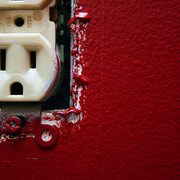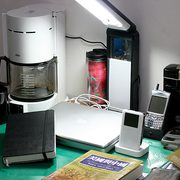Posts tagged with “Energy Sources & Uses” (All posts)
-
Our friends over at Williams had their take on this, and I wanted to add a few more points about the differences between Renewable Energy Certificates (RECs) and Offsets.
First of all, RECs and offsets are entirely different environmental commodities. There are many misconceptions about RECs and offsets, and while some will say that it is because vendors have been misleading, I think it is more likely due to the fact that they are both somewhat abstract concepts to consumers and it does require a fair amount of research to be able to understand the differences between them.
A REC, also referred to as a green tag, represensts the environmental benefits of one megawatt-hour of electricity generated by a renewable sources such as wind, solar, or small-scale hydropower. Another commonly cited benefit of RECs is that the money will incentivize the production of renewable energy resource.
As many of our readers probably know, with out turbine, Carleton’s renewable energy credits were sold to Xcel and served as a monetary incentive to construct our wind turbine. Though I was not at Carleton when talks about the turbine were taking place, it is easy to say that the project might not have been financed if Carleton hadn’t been able to sell the credits.
Continue by clicking the “read more” link below
-
Abandon Your Computer?!
You may have heard about Power Shift, but tomorrow Carleton students will participate in an event called ‘Power-Off.’ Organized by a Cinema and Media Studies (CAMS) class, the event aims to help Carleton students call attention to their own dependence upon technology by asking them to go 24 hours without the use of a computer. This means no music, no email, no word processing, and yes, faithful readers, no checking your favorite blog. Three of the students in the class are even going a whole month without the use of the computer. The project will culminate in a documentary that the class has been working on.
Clearly, there are positive, if unintended environmental consequences associated with this event, as students are being called to unplug from the electrical grid and get in touch with the real world, beyond computer monitors. Tom Schmidt, one of the students involved, mentioned that the class had discussed the possibility of being mistaken for one of the environmental groups on campus (which wouldn’t have been a negative, he assured me).
While Power-Off participants will be minimizing their energy use, they will also be forced to look elsewhere for entertainment and fulfillment. To counteract any possible separation anxiety, the group is also sponsoring a campus event modeled after popular online forms of interaction. From 12:00-12:30, they will hold a live chat room, followed by ‘Speed Friending’ from 12:30-1:00. Both events will occur in Great Hall.
-
EAC Minutes Posted
Miss the October 2nd or October 16th EAC meetings? Find out what happened in the minutes posted here.
-
This weekend, seven Carleton students representing all four classes will travel to College Park, Maryland for what is shaping up to be the largest youth conference on climate change ever–Power Shift 2007. There are currently over 5,000 students attending from all 50 states and the list of speakers and events is lengthy and still growing. On Saturday and Sunday, students will attend panels and workshops where they will learn about the current status of the climate crisis as well as how to make a difference on a local (specifically on their campuses), national and international level. Then, on Monday, the entire conference will rally at DC and spend a full day lobbying senators and representatives. Examples of available workshops are: Make Your Campus Climate Neutral, Sustainable Design on Campus, and a discussion of case studies on universities from around the country. The panels will include talks on the environmental priorities of the 2008 presidential candidates, briefings on the status of climate change legislation and much more.
The seven Carleton students were able to obtain funding from the CSA, the ENTS deparment as well as the office of the president and will depart on Friday (11/2) and return on Monday night (11/5). “It was no easy task to raise this money” says one of the organizers, Elizabeth Webb’09 , “but we can guarantee that Carleton’s presence at this conference will be a strong one and all attendees will return with invaluable skills and information about the climate crisis and what to do about it.” Plans for bringing some of the information back onto campus after the conference include a “chili night” that will take place in the winter with the support of the ENTS department to discuss some of the environmental options available to Carleton.
-
It is clear that air travel is a significant contributor to global climate change. Studies indicate that aviation is currently responsible for 3% of global carbon dioxide emissions and air travel is only becoming more and popular. In 1999, the Intergovernmental Panel on Climate Change (IPCC) reported that air plane greenhouse gas emissions will increase tenfold between 1992 and 2050. Traveling 2,000 miles in an airplane emits approximately the same amount of carbon dioxide as driving 1,900 miles in a mid-sized car. However, Greenhouse gases emitted from airplanes have particularly damaging effects because of the altitude at which gases are released.
These disheartening numbers may compel you to look into purchasing carbon offsets along with your next plane ticket. Fortunately, there are currently dozens of companies through which individuals or organizations can neutralize their carbon emissions from flying. Such offsets can take multiple forms: investing in renewable energy (such as wind, biomass or solar), energy-efficiency projects (such as compact fluorescent lights, refrigerators) or biological sequestration (such as planting trees that will uptake carbon). There is a range of quality and standards amongst carbon offset companies, yet, there is currently no universal regulatory body governing the way in which companies use consumers’ money. As such, it is up to consumers of these voluntary offsets to do their homework and ask lots of questions before choosing a company that they believe will most effectively offset their carbon emissions. When making this decision for yourself, you may want to check out company websites and send a few e-mails to find the answer to some of the following questions:
Is the carbon-offset company a non-profit or not? What percentage of their sales go towards operating costs? You may feel that you’re getting the most bang for your buck if a high percentage of your money is going directly towards offset projects. Non-profits generally put more money directly towards projects (as opposed to operating costs). However, it is not entirely clear how different companies define “project implementation” funds versus operating cost funds.
What sorts of projects do they invest in? Renewable energy and energy-efficiency projects avoid emissions, whereas as sequestration projects absorb emissions that have already entered the atmosphere. Sequestration projects generally deal with the land use. This can be a little bit of a bargain as it can be difficult to predict what sort of diseases or human activity will plague a forest in the future.
If the company is investing in projects that would be carried out regardless of your financial support or receives renewable energy credits for a project, in addition to selling you offsets, then you are not actually offsetting your emissions. Such a company would not be worth your money.
Continue by clicking the “read more” link below
-
Stories of corporations going green are everywhere. Companies are hiring “sustainability” managers, making large reductions in GHG emissions (despite only a few policy incentives), and publicizing their sustainability profiles in their quarterly financial reports.
While this is great news if we are really heading towards a paradigm shift from business as usual to a more sustainable model, getting there isn’t always very easy. In a Business Week article titled “Little Green Lies“, a former Rocky Mountain Institute employee who now works at Aspen Skiing Co. explains the struggles of going green.
From the story:
“Environmental stewardship has become a centerpiece of corporate image-crafting. General Electric (GE ) says it is spending nearly all of its multimillion-dollar corporate advertising budget on “Ecomagination,” its collection of environmentally friendly products, even though they make up only 8% of the conglomerate’s sales. Yahoo! (YHOO ) and Google (GOOG ) have proclaimed that by 2008 their offices and computer centers will become “carbon neutral.” Fueling the public relations frenzy is the notion that preserving the climate is better than cost-effective. But Schendler, who only a few years ago considered himself a leading proponent of this theory, now offers a searing refutation of the belief that green corporate practices beget green of the pecuniary variety.”
“His former mentor [Amory] Lovins says Schendler could find further cost-saving energy efficiencies with more support from his superiors. But this mind-set, Schendler warns, could influence companies to pursue exclusively projects with quick payoffs: “The idea that green is fun, it’s easy, and it’s profitable is dangerous. This is hard work. It’s messy. It’s not always profitable. And companies have to get off the mark and start actually doing stuff.”
Continue by clicking the “read more” link below
-
Without a doubt, emissions in China will have to be addressed if we are to solve climate change. China is currently adding two coal plants to its electricity grid every week. If this pace continues, global emissions will rise above any stabilization threshold, whether its James Hansen’s 450 ppm or the more conventional 550ppm.
However, what few people are pointing out today is what sectors China’s emissions are coming from. A recently released Tyndall Center report found that China’s net exports account for more than 23% of GHG emissions. These emissions are roughly equal to all of the UK. While the concept of exporting emissions isn’t a new topic, this is, as far as I know, the first time a number was estimated for China.
The Tyndall Report illustrates how the current GHG accounting process fails to fully account for western nations’ emissions and consumption. If US, UK, or Canadian products are produced in China, I don’t think we should be let off the hook for those emissions. If the US does implement legislation for reducing GHG emissions, in most scenarios, these exports will not be counted. Furthermore, if this is the case, will it not become an incentive to take more manufacturing jobs offshore? Perhaps this is good for development and growth in those countries, but shouldn’t the developing countries be allowed to increase emissions for their own economies but not for western nations’ consumption?
Continue by clicking the “read more” link below
-
The college gives away Compact Fluorescent Lights, so why not limit the amount of energy you use in your dorm room by simply installing them in your desk lamp?
Having recognized the major energy savings of using Compact Fluorescent Lighting (CFLs) (they use about a quarter of the energy used by traditional incandescent bulbs), the college has put CFLs in most light fixtures around campus (including dorm rooms) in the last few years. Because the college cannot control the type of bulbs students use in their personal lamps, Facilities simply gives CFLs to students for free. Call Facilities at x 4133.
And, make the switch soon. There is no need to wait until the incandescent bulb in your desk lamp burns out. Simply throw your incandescent light bulb in the trash. The sooner you make the switch, the sooner you’ll start saving energy. Currently, Facilities distributes the equivalent of 60 and 100 watt incandescent bulbs (used by most lamps) CFLs to students.
As a CFL user, there are a few things you should know. While naturally CFL use minimizes the amount of the pollutants (including mercury) pumped out of power plants, the CFLs themselves do contain trace amounts of mercury. While not a huge safety hazard, there are certain precautions you can take in the event that a CFL breaks or if you would simply like to get rid of them once they burn out.
Continue by clicking the “read more” link below
-
Sleep Mode= Power Drain
The Christian-Science Monitor has a great, short article about how the “sleep mode” on our electrical appliances still uses a lot of power.
From the article:
“In standby, a machine is not really turned off. It goes into a state of reduced activity that requires only minimal power consumption. The downside is that even at vastly reduced power levels, millions of machines running all day, every day, adds up to huge amounts of wasted energy. With oil prices at record highs and the climate under threat from excessive consumption of fossil fuels, this is neither smart nor desirable.”“The US Department of Energy has estimated that by 2010, the portion of each utility customer’s bill consumed by appliances in standby mode will reach 20”
(Hat tip to RFF’s Common Tragedies)
-
“Try this experiment. Go knock on someone’s door in West Oakland, Watts or Newark and say: ‘We gotta really big problem!’ They say: ‘We do? We do?’ ‘Yeah, we gotta really big problem!’ ‘We do? We do?’ ‘Yeah, we gotta save the polar bears! You may not make it out of this neighborhood alive, but we gotta save the polar bears!’ ”
If this key communication disconnect continues, Jones, a visionary Oakland-based activist, explains, we will never find solutions to either social inequality or environmental destruction. Instead, we need a “green economy strong enough to lift people out of poverty.” Green For All, based out of the Ella Baker Center for Human Rights in Oakland, seeks to bring “green collar” jobs to urban areas. If young people of color start installing solar panels now, explains, Jones, they’ll become managers in five years, owners in ten, and eventually inventors.
The publicity this initiative has been enjoying the past week (New York Times and The Nation) speaks to the revolutionary nature of the program, and a revolution people have been waiting for. Van Jones believes these two movements have been separated for too long, and his passion is contagious. The fight to curb climate change has literally been a fight to maintain the environmental status quo, a conservative approach that turns off many people who do not benefit from the way things are. Van Jones’ environmental revolution provides hope for both sides of the double helix—-hope for a more inclusive, diverse environmental movement, and hope to lift people of color out of poverty.
Categories
- Building and Planning
- Carleton's Wind Turbines
- Climate Change
- Conferences
- Cowling Arboretum
- Ecosystem Management
- Emissions and Offsets
- Energy Sources & Uses (Current Category)
- Environmental Justice
- Events
- Food
- Higher Education
- International News
- National News
- News
- STA Program
- Student Life
- Student Projects
- Sustainability
- Sustainable Planning & Development
- Transportation
- Waste







